Malayan Pit Viper
Malayan Pit Viper or Malaysian Pit Viper (Calloselasma rhodostoma)
[Page Updated: 21 June 2023]
The Malayan Pit Viper is a medium sized venomous snake growing up to around 1 metre, native to tropical Southeast Asia. The Malayan pit viper is found in forest edges between Myanmar (Burma) & Vietnam also further south through peninsular Malaysia, to the islands Sumatra and Java.
The Malayan Pit Viper is an unusual snake in that it broods. The female will lay one to two dozen egg in August or Septembre and wrap her body around the eggs until they hatch after six weeks. During the incubation, she protects her eggs from intruders. The hatchlings measure 6 inches (15 cm) in length and have the same coloration as adults.
The crown is large and triangular with large plates. The eyes are vertically oriented pupils. The pit or depression that is located between the nostril and each eye acts as a heat detector to locate prey based on their temperature difference with the surrounding air. The body is a pinkish gray color with large brown triangles bordered by white along the sides. From the neck to the tail, a thin black line runs along its back.
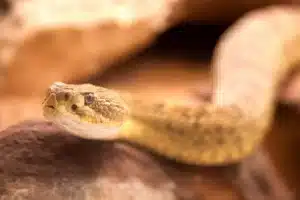
Thais say: Ngoo gap pa
Length: Usually less than 1 meter. Female Malayan Pit Vipers are the larger and fatter snakes. Males of the species don’t make it to 1 meter long. I have only seen two in 12 years that were close to 1 meter long.
Range: Thailand, Laos, Cambodia, Java, Sumatra, Malaysia, Vietnam, Burma, and China.
The Malayan Pit Viper is similar to the copperhead and moccasin pit vipers in North America. It was previously placed with these pit vipers under the genus Agkistrodon. Malayan moccasin is another name for the Malayan viper. Pit vipers belong to the Viperidae subfamily of the viper family. Crotalidae is a family of crotalids that some authorities classify them as.
During the day, it hides in thickets of leaves, fallen logs or thickets. At dusk it becomes active, searching for small mammals, birds and frogs. It coils and vibrates its tail when disturbed. This creates a rattling noise among the debris and leaves. It can flatten and spread its ribs to defend itself from predators. Accidental bites to humans can be extremely damaging due to the long fangs of this snake and its powerful venom. However, there are very few fatalities. Malayan pit vipers are bred in laboratories to produce antivenin, and study a coagulant found in their venom.
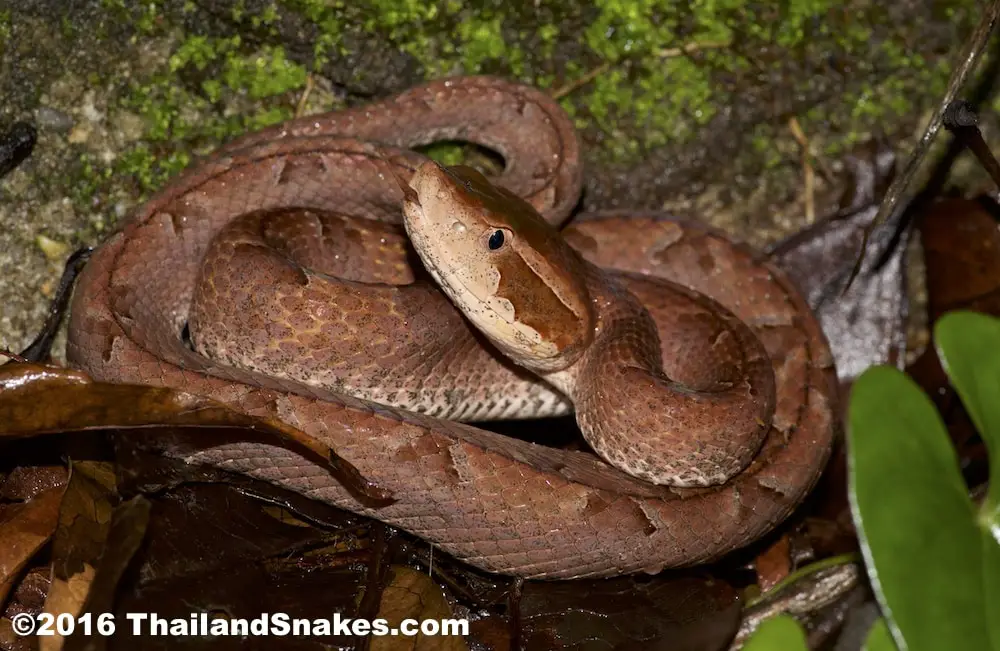
Notes: These vipers are similar to North American “copperhead” snakes. They prefer dry, flat areas. They are known as lazy snakes. They may not move out of the way at all if someone is walking right toward them. After they bite they are known to remain in the same location. There are thousands of bites per year in Malaysia and Thailand from this snake.
These snakes are so dangerous when handled because they are not consistent with their behavior. One day they will be calm. The next, or the next 10 minutes – they will violently strike out lightening fast. Their preferred habitat is under dry leaves, wood, or rocks. They are active during the night mostly, especially during rain.
Thailand Snakes – Venomous and Non-Venomous snake information!
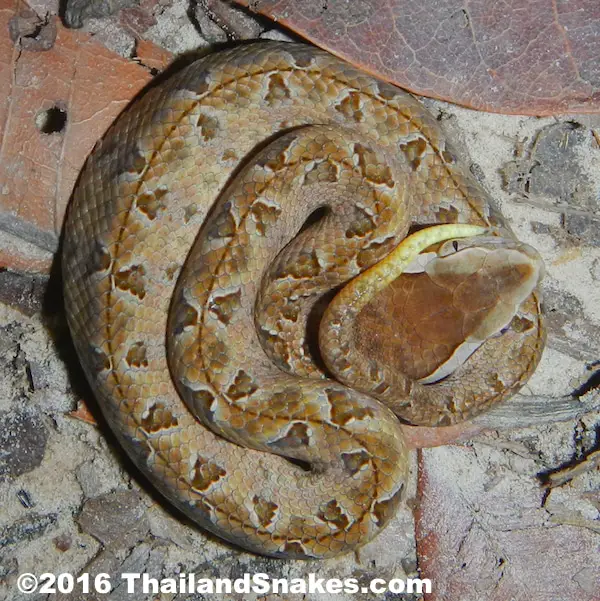
Nickname: Finger rotters – given by Al Coritz, Viperkeeper on YouTube. If they get you in the finger – you’ll likely lose part of your finger, hand, or arm without immediate care.
Habitat: Forests, rubber plantations, bamboo patches, farmland, grassland. Often lies in the short or long grass. These are terrestrial snakes that I’ve never seen climb anything.
Active Time? Day if cloudy and/or rainy, and night.
Food: Mice, frogs, lizards. Predominantly rodents.
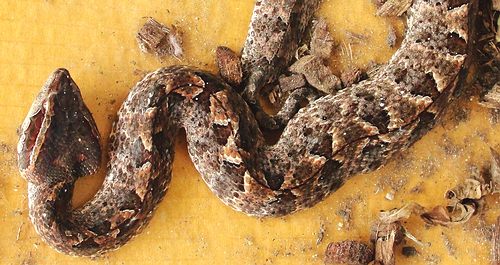
Thailand Snakes – Venomous and Non-Venomous snake information!
Defensive Behavior: Partially coiled with neck in an “S”. Their strike is very fast. Their fangs are long – and in the front of the mouth. Some strikes are short, others involve the whole body as it “jumps” at the same time it strikes. Don’t underestimate the distance this snake can reach when striking. Also, this snake is VERY good at striking behind its head. Watch the video.
This pit viper has the longest fangs of any other snake in Thailand – including the Siamese Viper (D. siamensis).
King Cobras eat Malayan Pit Vipers. Larger Malayan Kraits may also eat them, but the interactions I’ve seen between them haven’t led to that.
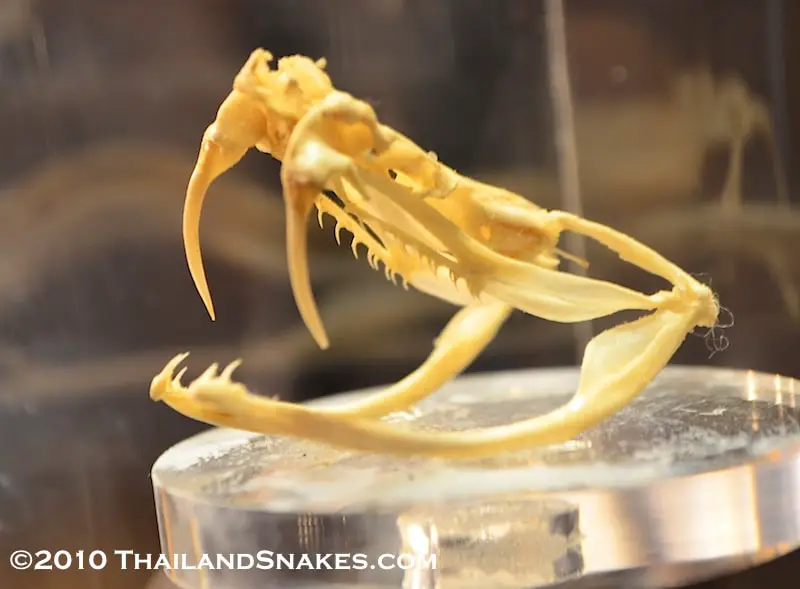
Venom Toxicity: Very toxic. Venom is necrotoxic – it destroys all cells it comes in contact with – red blood cells, muscle, and ligaments. With a quick hospital visit after a bite you may just lose part of your finger or some tissue where the bite occurred. The venom causes a bite victim to bleed from body orifices – eyes, nose, mouth, ears, sexual organs, and sometimes fatally in the brain. Most people don’t die if they go to the hospital. Deaths occur when bite victims delay seeking medical treatment. There is an antivenom for this snake.
If you are bitten by this snake, do NOT wrap a tight band around the bite location. That will stop the venom from moving, from being diluted, and the tissue will suffer much more destruction.
Offspring: Lay eggs. Female guards them. Young are about 9 inches long and fast and thin. They are fully able to bite and have full-strength venom.
Malayan Pit Viper Eating Mouse Video – close-up of large fangs, strike, etc.
Malayan Pit Viper Scientific Classification
Kingdom: Animalia
Phylum: Chordata
Class: Reptilia
Order: Squamata
Suborder: Serpentes
Family: Viperidae
Subfamily: Crotilinae
Genus: Calloselasma
Species: C. rhodostoma
Binomial Classification:
Calloselasma rhodostoma
Video – Malayan Pit Viper Color Variety in Thailand
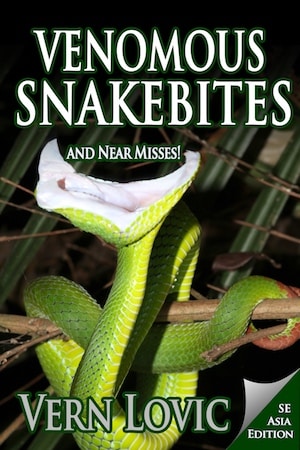
Venomous Snakebites Stories!
More than 34 stories of venomous snakebite and very near misses from Southeast Asia’s most deadly snakes – King Cobra, Malayan Pit Viper, Monocled Cobra, Banded Krait, Malayan Krait, and more! Digital Book with over 100 pages by Vern Lovic.
Order at Amazon here
JUST $4.99 for the eBook!
We also put out a FREE ebook you can get today.
Photos of Common Thailand Snakes
[ click to join for free and get your copy now]
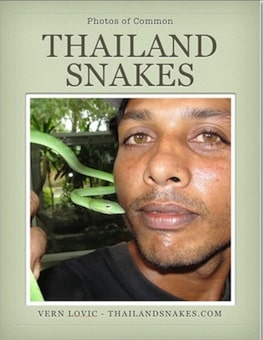

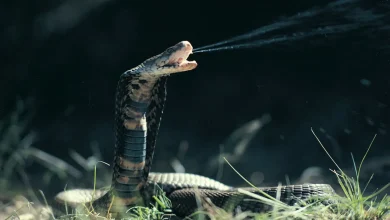
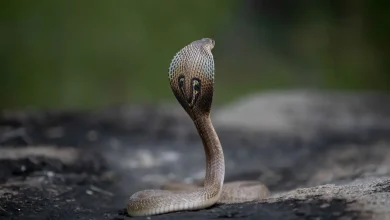
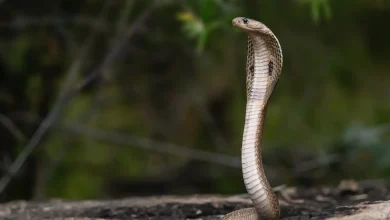
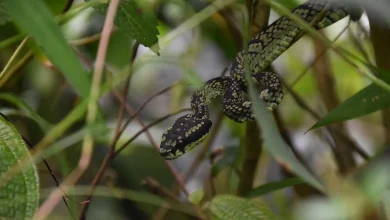
Thanks
Shes doing much better, fortunately she only got one fang in her pointer finger the other fang grazed her ring finger , lots of localized swelling but after 2 days in the hospital much better. Nothing so far looks necrotic–Cheers!
My wife saw a Malayan pit viper,the darker colour climb down a 6ft garden wall that had vine attached to it.It was about 1 ft long and when my wife called me over it was on the ground and for a while I couldn’t see it,then I did coiled up.,Good camouflage.
Interesting, they’re not really climbers.
Something about the weather is driving snakes out in the fields, roads and / or homes. My daughter met face to face with a Spitter cobra, in the side yard, yesterday. In January of this year we had 2 spitters in the front yard, as there is a canal that runs along the road in front of the house. A year and a half ago, we saw our first MPV in the outdoor garage. It buffaloed the wife and had her running as it moved at her, not away. We retired to inside our home until a bit of time passed. Since then she has dispatched every snake she has seen, got to educate her somehow….